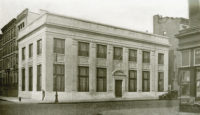New York, New York
Milan-based architect Matteo Thun strives to “respect the soul of a place.” So when the German fashion giant Hugo Boss tapped him to design a new concept shop that would showcase all of its tony brands within a gutted former food market in New York City’s Meatpacking District, he developed a program influenced by the site’s gritty past and urban locale. Thun’s design for the store also reflects the corporate image he began crafting with his architecture in 2006 for the Switzerland-based headquarters of the company’s Strategic Business unit. There, he devised a daylight-filled, low-lying building that nestles into a bucolic setting—its glazed curtain wall enveloped by a wooden latticelike “super” structure evocative of the surrounding vineyards.
The architect realized this strategy for the New York City space through a seemingly simple yet intricate intervention. He fit two thirds of the gutted 4,035-square-foot interior with a scaled-down modular variation of the Swiss headquarters’ cross-hatched superstructure. Made out of white oak, this curvilinear grid is much more than an architectonic reference, however. It creates a bold yet inviting juxtaposition with the old market’s original concrete structure, which Thun left virtually intact as a raw backdrop. Additionally, the arched trellislike form provides a flexible base for the store’s lighting and display systems. “It’s pure function,” says Thun. “And it never touches the structure of the building.”
The design accommodates the temporary nature of retail venues, explains the architect, “[The shop] is easy to keep as long as it’s viable.” Yet everything is removable, and the finishes and footprint were left as close to the original as possible. For instance, Thun kept the old concrete floor—only smoothing and polishing it. He stripped one wall to the brick. Opposite, he insulated a common wall with a neighboring boutique, faced it with drywall, then painted it a neutral gray. He kept the columns as they were—peeling and partially stripped.
Working with American lighting designer A.J. Weissbard—whose international scope of work encompasses architectural installations, theater, opera, dance, exhibitions, and video—Thun then focused on a lighting scheme that would not only set the stage for an enhanced shopping experience but intrigue passersby, no matter what the time of day or night. In essence, he claims, “The investment is just light, and nothing else.”
According to Weissbard, his job was to establish a certain ambient look where everything—objects and merchandise—is made more dramatic through the use of light. “We wanted to keep the ambient levels dark, much darker than those typically found in Hugo Boss stores, and devise a system that would pull everything out from this void.” At the same time, the design team focused on “highlighting the character of the walls to maintain as much of the character of the building as we could in the renovation,” says Weissbard.
The resulting plan combines several types of lighting. Besides traditional metal-halide track lights directed at merchandise—set on burnished-iron, wood, brown-lacquer, leather, and glass displays—different LED systems wash the walls: a Kelvin mixing system that ranges from warm to cold for the brick wall and an RGB (red, green, blue) and white one for the painted wall opposite, dubbed “the new wall.” Weissbard located the wiring and LED modules on the back side of the oak structure’s vertical segments, as well as in washers installed at the top and bottom of both walls. The building’s concrete-faced steel columns are washed by the same Kelvin system as the brick wall.
“Then there is what we call the ‘starry sky,’ ” says Weissbard. A series of small LED spots placed at the intersecting points along the lattice ceiling, this system works as a low-resolution video surface programmed for different effects. For example, the color and level of light can change throughout the course of the day. At night, the lights directed on the garments turn off so that the shell becomes prominent. The RGB-lit wall, which the architect claims will soon become a palette for local stencil artists, receives the same treatment—with changing light effects animating its surface.
To contrast with the raw main space, Thun created luxurious dressing rooms at the back of the selling floor behind a privacy “focus wall” made of highly reflective solar glazing—smoky taupe mirror from the front, transparent window from behind. Topped by a golden ceiling and filled with area rugs, red velvet drapes, and ample mirrors, this entire area is bathed in a warm, bright glow ideal for seeing the clothing. Here, indirect fluorescent cove lighting is supported by the addition of direct unfiltered light—to complement skin tones—in the form of elegant incandescent chandeliers.
“I wanted a system that is quite flexible,” says Weissbard. “In the end, we created one that we program, but that [store personnel] can control.” In an ongoing process, once programs are installed, the shop’s staff can select from different lighting sequences to suit the desired environment—whether that be for selling during day or evening hours, or for situations when the store is closed. In the future, says Weissbard, the system can even be programmed to suit a variety of events, such as parties and art installations. “The space is very flexible in that sort of way,” he says. “It’s not locked down to just the [demands of] the store.”




Post a comment to this article
Report Abusive Comment